美国大学英语写作:Chapter 13_对比和比较[优质ppt]
- 格式:ppt
- 大小:151.00 KB
- 文档页数:15

英语写作-对⽐⽐较讲课讲稿英语写作-对⽐⽐较Writing A Comparison / Contrast ParagraphAIMS:ordering material using the point-by-point method or the block methodimproving coherence by using transitional phrases common to comparison/contrast writing taking a step-by-step approach to create comparison/ contrast paragraphsstudying model paragraphs to create comparison/ contrast paragraphsComparison shows similarities between persons, places, things, ideas, or situations.Contrast points out the differences between persons, places, things, ideas, or situations.Two Basic Methods for Organizing Comparison / Contrast Paragraphs1. If you let A and B stand for the two things (subjects) being compared, then you can use the block method in which you tell all about A, then tell all about B. Thus you discuss A in a block and B in a block.2. If you let A and B stand for the two things (subjects) being compared, then you compare them point by point. Every time you say something about A, you also say something about B – right in the same sentence or in the sentence immediately following.The Topic SentenceYour topic sentence should identify both items (subjects) to be compared or contrasted and tell the reader exactly what you are going to say about these items (attitude).e.g., (poor) Our pup, Tuffy is different from our cat, Hector.(good) The difference in temperament between our pup, Tuffy, and our cat, Hector, is a constant source of amusement.The BodyOnce you have decided on a good topic sentence, list all the points of comparison/ contrast that you can think of. Next, reviewthe list and eliminate any points, which are irrelevant or unimportant. Now, organize your details in a logical sequence, and begin your rough draft.The ConclusionThe most effective conclusion for a comparison/contrast paragraph is usually a final sentence, which reinforces the controlling idea.e.g., If you could see Tuffy and Hector together, you could scarcely help laughing at the contrast between these two household playmates.A Good Example of the Block Method:Students who have Mr. Jones and Mr. Smith are immediately aware of the difference in the lecturing manner of each teacher. Mr. Jones has a pleasant voice, which helps hold the interest of the students. He pronounces clearly in a rhythmic pattern emphasizing key words. His moderate tone and inflected words make his lectures interesting. Mr. Jones also adds humour to his subject, and hewel comes questions from students who don’t understand the material. He takes his time and explains slowly. He tries to make sure that his students understand a concept before he moves on to something new, and he is very enthusiastic about his subject. Mr. Smith, on the other hand, has a different tone, pronunciation, expression and attitude from Mr. Jones. He has a booming voice, which commands rather than teaches, and sometimes it is hard to understand because he runs his words together. His lectures are not as interesting as those of Mr. Jones, either, because Mr. Smith speaks in a boring monotone. He also hates to be interrupted; feeling that he must cover everything. Mr. Smith teaches every class in a serious, determined mood. Thus, as the above points illustrate, the lectures of Mr. Jones and Mr. Smith are quite different.A Good Example of the Point-by-Point Method:Students who have Mr. Smith and Mr. Jones are immediately aware of the difference in the lecturing manner of each teacher. Mr. Jones has a pleasant voice, which helps hold the interest of the students. Mr. Smith, however, has a booming voice, which commands rather than teaches. Mr. Jones pronounces clearly in a rhythmic pattern emphasizing key words. On the other hand, Mr. Smith mumbles, running his words together. The moderate tone and inflected words of Mr. Jones make his lectures more interesting than those of Mr. Smith, who speaks in a boring monotone. Mr. Jones also adds humour to the subject, whereas Mr. Smith is always serious about each lesson. Mr. Jones welcomes questions from students who don’t understand the material, as compared to Mr. Smith who hates to be interrupted. Mr. Jones takes his time and explains slowly, whereas Mr. Smith rushes through each lesson. Mr. Jones is very enthusiastic about his subject: he tries to make sure everyone understands a concept before he moves on to something new. Mr. Smith, however, is always in a determined mood; he feels that he must cover everything. Each teacher has a different voice, tone, pronunciation, expression, and attitude: and as a result, their lectures are quite different. COMPARE AND CONTRAST Key Wordscomparison:like similar as same in the same way too bothmost important have in common the same as similarly as well as。
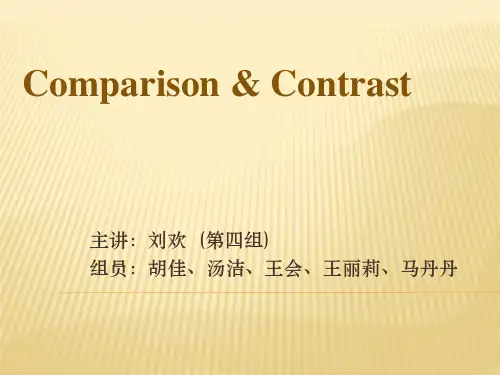

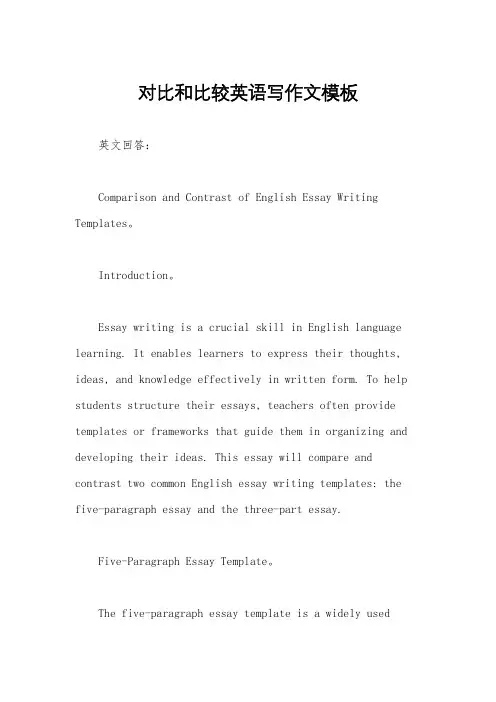
对比和比较英语写作文模板英文回答:Comparison and Contrast of English Essay Writing Templates。
Introduction。
Essay writing is a crucial skill in English language learning. It enables learners to express their thoughts, ideas, and knowledge effectively in written form. To help students structure their essays, teachers often provide templates or frameworks that guide them in organizing and developing their ideas. This essay will compare and contrast two common English essay writing templates: the five-paragraph essay and the three-part essay.Five-Paragraph Essay Template。
The five-paragraph essay template is a widely usedstructure in English writing. It consists of five distinct paragraphs:1. Introduction: This paragraph introduces the topic of the essay, provides a brief overview of the main points, and includes a thesis statement that states the main argument or claim.2. Body Paragraph 1: This paragraph presents the first supporting point for the thesis statement, providing evidence, examples, or explanations.3. Body Paragraph 2: This paragraph presents the second supporting point for the thesis statement, providingfurther evidence, examples, or explanations.4. Body Paragraph 3: This paragraph presents the third and final supporting point for the thesis statement, providing additional evidence, examples, or explanations.5. Conclusion: This paragraph restates the thesis statement, summarizes the main points, and provides aconcluding statement that reinforces the essay's argument.Three-Part Essay Template。

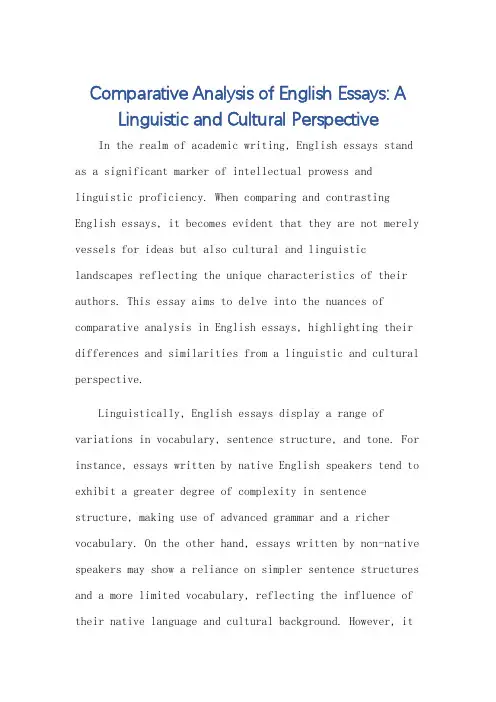
Comparative Analysis of English Essays: A Linguistic and Cultural PerspectiveIn the realm of academic writing, English essays stand as a significant marker of intellectual prowess and linguistic proficiency. When comparing and contrasting English essays, it becomes evident that they are not merely vessels for ideas but also cultural and linguistic landscapes reflecting the unique characteristics of their authors. This essay aims to delve into the nuances of comparative analysis in English essays, highlighting their differences and similarities from a linguistic and cultural perspective.Linguistically, English essays display a range of variations in vocabulary, sentence structure, and tone. For instance, essays written by native English speakers tend to exhibit a greater degree of complexity in sentence structure, making use of advanced grammar and a richer vocabulary. On the other hand, essays written by non-native speakers may show a reliance on simpler sentence structures and a more limited vocabulary, reflecting the influence of their native language and cultural background. However, itis noteworthy that even non-native speakers can achieve a high level of linguistic proficiency in English essays with sufficient practice and exposure.Cultural differences also play a pivotal role in the comparative analysis of English essays. Essays written by authors from different cultures often reflect their unique worldviews, values, and beliefs. For instance, essays from Western cultures may emphasize logic, rationality, and objectivity, while essays from Eastern cultures may prioritize harmony, subjectivity, and contextual understanding. These cultural differences can significantly influence the way authors approach their topics, organize their arguments, and convey their ideas.Despite these differences, there are also significant similarities in English essays across cultures. Firstly, English essays, regardless of their cultural background, aim to convey clear and coherent arguments supported by evidence and analysis. Secondly, they all require a high degree of organization and coherence, ensuring that the reader can follow the argument from beginning to end. Lastly, English essays share a common goal of promotingcritical thinking and intellectual growth, encouraging authors to explore and evaluate ideas from multiple perspectives.In conclusion, the comparative analysis of English essays offers a fascinating glimpse into the intersectionof language, culture, and intellectual pursuits. Whilethere are significant differences in linguistic proficiency and cultural perspectives across essays, they also share common goals and standards of academic writing. Understanding these differences and similarities is crucial for effective cross-cultural communication and intellectual exchange.**英语作文对比与评析:语言与文化的双重视角**在学术写作领域,英语作文作为一种重要的思想表达和语言能力的体现,具有显著的地位。
![comparison and contrast对比 英文写作[优质PPT]](https://uimg.taocdn.com/5b9b1e18561252d380eb6ee0.webp)
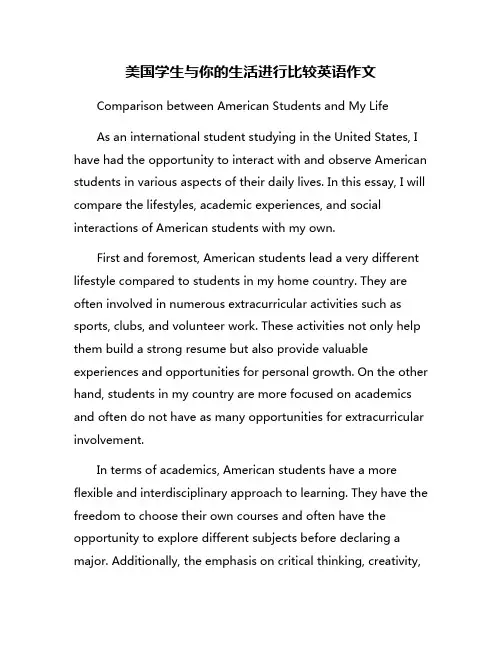
美国学生与你的生活进行比较英语作文Comparison between American Students and My LifeAs an international student studying in the United States, I have had the opportunity to interact with and observe American students in various aspects of their daily lives. In this essay, I will compare the lifestyles, academic experiences, and social interactions of American students with my own.First and foremost, American students lead a very different lifestyle compared to students in my home country. They are often involved in numerous extracurricular activities such as sports, clubs, and volunteer work. These activities not only help them build a strong resume but also provide valuable experiences and opportunities for personal growth. On the other hand, students in my country are more focused on academics and often do not have as many opportunities for extracurricular involvement.In terms of academics, American students have a more flexible and interdisciplinary approach to learning. They have the freedom to choose their own courses and often have the opportunity to explore different subjects before declaring a major. Additionally, the emphasis on critical thinking, creativity,and collaboration in the American education system is significantly different from the more rote-learning approach in my home country.Socially, American students are very outgoing andopen-minded. They are always eager to meet new people, make friends, and engage in social activities. They have a strong sense of community and often participate in events such as parties, game nights, and study groups. In contrast, students in my country tend to be more reserved and usually stick to socializing with their close circle of friends.Despite these differences, I have found that there are also many similarities between American students and myself. We all share a desire to succeed academically, pursue our passions, and make a positive impact on the world. We all face challenges and obstacles in our lives, but we strive to overcome them with determination and resilience. Ultimately, the experiences and interactions with American students have enriched my life and broadened my perspective on the world.In conclusion, the comparison between American students and my own life has highlighted the diverse yet interconnected nature of our experiences. While there are certainly differences in our lifestyles, academic experiences, and social interactions,there are also many similarities that unite us as students navigating the challenges and opportunities of higher education. Through this comparison, I have gained a deeper appreciation for the unique experiences and perspectives of American students and have recognized the common humanity that binds us all together.。

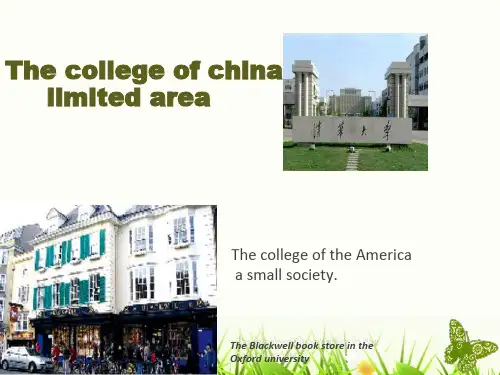
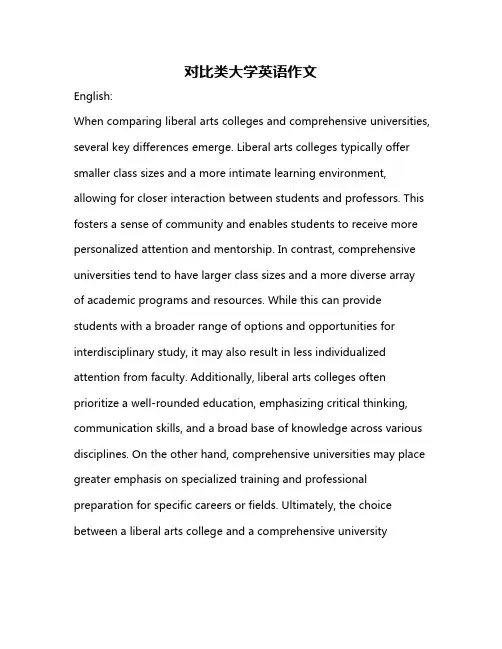
对比类大学英语作文English:When comparing liberal arts colleges and comprehensive universities, several key differences emerge. Liberal arts colleges typically offer smaller class sizes and a more intimate learning environment, allowing for closer interaction between students and professors. This fosters a sense of community and enables students to receive more personalized attention and mentorship. In contrast, comprehensive universities tend to have larger class sizes and a more diverse arrayof academic programs and resources. While this can provide students with a broader range of options and opportunities for interdisciplinary study, it may also result in less individualized attention from faculty. Additionally, liberal arts colleges often prioritize a well-rounded education, emphasizing critical thinking, communication skills, and a broad base of knowledge across various disciplines. On the other hand, comprehensive universities may place greater emphasis on specialized training and professional preparation for specific careers or fields. Ultimately, the choice between a liberal arts college and a comprehensive universitydepends on factors such as academic interests, learning preferences, and career goals.中文翻译:在比较文理学院和综合性大学时,会出现几个关键的区别。
中美学生生活对比In the vast landscape of education, the experiences of students from different cultures often vary significantly. This essay aims to compare and contrast the lives of American students with mine, highlighting the differences and similarities in our academic, extracurricular, and personal pursuits.Firstly, let's delve into the academic sphere. American education systems, particularly at the higher levels, often emphasize critical thinking, analytical reasoning, and innovative problem-solving. This is reflected in the curricula, which encourage students to engage with complex issues, question assumptions, and seek original solutions. In contrast, the Chinese education system tends to focus more on knowledge accumulation and test-taking skills. While there is a growing emphasis on critical thinking, the traditional focus on mastering textbooks and passing exams remains.Extracurricular activities also exhibit distinct characteristics. American students often have a wide array of clubs and organizations to choose from, ranging fromsports teams to academic clubs and social organizations. These provide ample opportunities for students to pursue their passions, develop leadership skills, and build social networks. By contrast, while extracurricular activities are also prevalent in China, they tend to be more focused on academic competitions and preparation for future professions.In terms of personal pursuits, American students often enjoy a greater degree of freedom and choice. They are encouraged to explore their interests, whether it be through hobbies, travel, or part-time work. This fosters a culture of independence and self-discovery. By contrast, Chinese students, while also having interests and hobbies, often face greater pressure to prioritize academic success, which can sometimes limit their opportunities for personal growth and exploration.However, despite these differences, there are also significant similarities. Both American and Chinese students share a common goal of achieving academic excellence and preparing for future careers. We both strive to master new knowledge, develop critical thinking skills,and cultivate leadership qualities. Furthermore, we both face challenges and pressures, whether it be exam stress, career uncertainty, or the pursuit of personal goals.In conclusion, while there are numerous differences in the lives of American students and mine, there are also many similarities. Both systems have their strengths and weaknesses, and it is important to recognize and appreciate the diversity of educational experiences worldwide. Bydoing so, we can gain a broader perspective, enhance our understanding of other cultures, and ultimately, grow as individuals and as global citizens.**中美学生生活对比**在教育的广阔天地中,来自不同文化背景的学生的经历往往大相径庭。
英语写作比较和对比范文Title: The Beauty of Contrast: Comparing Traditionaland Modern Forms of Art.Art, in its various forms, has always been a reflection of society, culture, and the times. The evolution of art over the centuries has been fascinating, with each period leaving its unique imprint on the canvas. This essay aimsto compare and contrast traditional and modern forms of art, exploring the differences and similarities that define them.Traditional Art.Traditional art, often rooted in historical andcultural contexts, has a sense of permanence and stability. It is often associated with specific geographical regions, reflecting the values, beliefs, and aesthetics of aparticular community or era. Traditional artists often draw inspiration from nature, mythology, and religious texts, creating works that are both visually appealing and deeplysymbolic.The techniques used in traditional art are often well-established and passed down through generations. These techniques, whether it be painting, sculpture, or embroidery, require years of practice and mastery. The finished works are often highly detailed, with every stroke, line, and color carrying deep meaning and symbolism.Modern Art.In contrast, modern art is often associated with innovation, experimentation, and a rejection of traditional norms. It emerged in the late 19th and early 20th centuries, challenging the established artistic canons and pushing the boundaries of what was considered acceptable in art.Modern artists explored new mediums, techniques, and subject matter, often focusing on abstract or non-representational forms. They aimed to express their feelings, thoughts, and ideas through their works, rather than simply creating visually appealing images. Thefinished works are often jarring, unexpected, and thought-provoking.Comparison and Contrast.While traditional and modern art might seem vastly different at first glance, they share certain fundamental principles. Both forms of art aim to communicate a message or evoke a feeling in the viewer. They both require creativity, skill, and dedication to create meaningful works.However, the methods and means through which they achieve these goals are vastly different. Traditional art relies on established techniques and subject matter, while modern art pushes the boundaries of what is considered acceptable. Traditional art is often rooted in history and culture, while modern art is often experimental and innovative.The reception of these two forms of art also differs. Traditional art is often admired and appreciated for itscraftsmanship and historical significance, while modern art can be polarizing, with some finding it confusing or even offensive.Conclusion.In conclusion, traditional and modern art are twodistinct yet complementary forms of expression. They each have their unique strengths and weaknesses, and their differences reflect the changing times and societal values. By comparing and contrasting these two forms of art, wegain a deeper understanding of not only the art itself but also the cultures and values that shaped them.The beauty of art lies in its ability to evoke feelings, thoughts, and ideas in the viewer. Whether it is theintricate detailing of a traditional painting or theabstract expressions of a modern sculpture, art has the power to move us in profound ways. By embracing both traditional and modern forms of art, we open ourselves to a richer, more diverse, and ultimately more fulfillingartistic experience.。
对比比较英语作文写作模板Comparison and Contrast English Composition Writing Template。
When it comes to writing an English composition, there are various ways to approach the task. One of the most effective methods is through the use of comparison and contrast. This technique allows the writer to explore the similarities and differences between two or more subjects, providing a deeper understanding of the topic at hand. In this article, we will discuss the key components of a comparison and contrast English composition writing template.Introduction:The introduction sets the stage for the rest of the composition. It should provide a brief overview of the subjects being compared and contrasted, as well as a clear thesis statement that outlines the main points of the composition. The introduction should also grab the reader's attention and make them interested in the topic.Body Paragraphs:The body paragraphs of a comparison and contrast English composition should focus on the similarities and differences between the subjects. Each paragraph should address a specific point of comparison or contrast, and provide evidence to support the writer's claims. It is important to use clear and concise language, and to organize the information in a logical manner. Additionally, the writer should use transition words and phrases to guide the reader through the composition and make connections between the different points being discussed.Conclusion:The conclusion of a comparison and contrast English composition should summarize the main points of the composition and restate the thesis statement. It should also provide some insight or reflection on the significance of the comparisons and contrasts that weremade. The conclusion should leave the reader with a sense of closure and a deeper understanding of the topic.Example:To illustrate this template, let's consider an example of a comparison and contrast English composition. Suppose we are comparing and contrasting the benefits of living in a city versus living in the countryside. The introduction would provide a brief overview of the topic and a thesis statement outlining the main points of the composition. The body paragraphs would then focus on specific aspects of city and countryside living, such as cost of living, access to amenities, and quality of life. Each paragraph would provide evidence to support the writer's claims, and use transition words and phrases to guide the reader through the composition. Finally, the conclusion would summarize the main points of the composition and provide some insight into the significance of the comparisons and contrasts that were made.In conclusion, a comparison and contrast English composition writing template is a useful tool for exploring the similarities and differences between two or more subjects. By following the key components outlined in this article, writers can create effective and engaging compositions that provide a deeper understanding of the topic at hand. Whether comparing and contrasting different cultures, historical events, or literary works, this template can be applied to a wide range of topics and subjects.。
美国学生与你的生活进行比较英语作文American students and Your Life: A ComparisonIntroduction:As students, we are constantly surrounded by different cultures and traditions, and it is interesting to compare our own lives with those of students in other countries. In this essay, we will compare the lives of American students with our own, focusing on various aspects such as education, lifestyle, and social activities.Education:One of the biggest differences between American students and us is the education system. In the United States, students have a more flexible curriculum, with a wide range of elective courses available. They also have the option to choose their major in college, giving them greater control over their academic path.In comparison, our education system is more structured, with a set curriculum and fewer elective courses. Our choice of major is often determined by our performance in high school exams, rather than our personal interests.Lifestyle:American students lead a more independent lifestyle compared to us. Many of them move away from home to attend college and live on campus or in shared accommodation. They are responsible for managing their own finances, cooking their own meals, and doing their own laundry.On the other hand, most of us students in our country still live with our families while studying. Our parents often provide for us financially, and we rely on them for meals and other household chores. This can create a more sheltered and dependent lifestyle compared to American students.Social Activities:American students are known for their vibrant social life, with a wide range of clubs, societies, and events on campus. They have opportunities to participate in sports, music, drama, and other extracurricular activities, which helps them develop social skills and build a network of friends.In comparison, our social life revolves more around family and close friends. While we also have clubs and societies in our schools, the emphasis is more on academics and less onextracurricular activities. This can limit our exposure to new experiences and perspectives.Conclusion:In conclusion, there are significant differences between the lives of American students and ourselves. While American students enjoy more flexibility in their education, independence in their lifestyle, and a vibrant social life, we have a more structured education system, a more sheltered lifestyle, and a focus on academics over extracurricular activities.By comparing our lives with those of American students, we can learn from each other and gain a better understanding of different cultures and traditions. It is important to appreciate the strengths and weaknesses of both systems and strive to create a balanced approach to education, lifestyle, and social activities in our own lives.。
美国学生与你的生活进行比较英语作文Comparing American Students to Your LifeWhen it comes to comparing American students to our own lives, there are a number of differences that we can consider. From the way they study to the way they spend their leisure time, there are a variety of aspects in which American students differ from students in other countries. In this essay, we will delve into the differences between American students and how they may contrast with our own experiences.One notable difference between American students and students from other countries is their educational system. In the United States, students typically attend school from a young age, starting with kindergarten and progressing through to their high school graduation. They have a diverse range of subjects to study, including mathematics, science, English, and social studies. American students are encouraged to participate in extracurricular activities such as sports, music, and clubs, which help to develop their interests and social skills.In contrast, students in other countries may have a more rigid education system, with a focus on academic subjects and less emphasis on extracurricular activities. For example, in someAsian countries, students may spend long hours studying and preparing for exams, resulting in less time for hobbies and socializing. This can lead to more pressure and stress for students in these countries compared to their counterparts in the United States.Another difference between American students and students from other countries is their social lives. American students are known for their diverse friendships and social circles, often interacting with classmates from different backgrounds and cultures. They may attend parties, events, and social gatherings with their peers, creating a vibrant and dynamic social scene.On the other hand, students in other countries may have more limited social interactions, often sticking to close-knit groups of friends from their school or neighborhood. This can result in a more insular social life, with fewer opportunities to meet new people and experience different cultures.In terms of leisure time, American students have a wide range of activities to choose from. They may spend their weekends hiking, going to the beach, shopping, or attending concerts and movies. American students also enjoy spendingtime with their families, going on vacations, and participating in community events.In contrast, students in other countries may have fewer options for leisure activities, depending on their location and resources. They may spend their weekends helping out with household chores, studying for exams, or simply relaxing at home. This can lead to a more limited range of experiences and opportunities for personal growth compared to American students.Overall, there are a number of differences between American students and students from other countries that can impact their educational, social, and leisure experiences. By considering these differences, we can gain a better understanding of the unique aspects of American student life and how it compares to our own.。